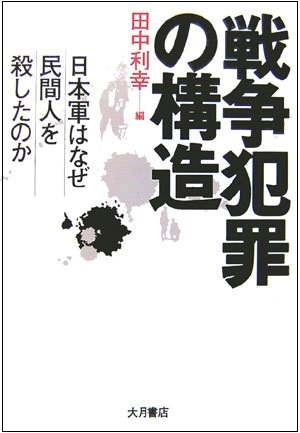
田中利幸/編(大月書店、2007年)
アジア太平洋戦争(1931~45年)の15年間において、日本軍がアジア太平洋各地の占領地域で一般市民に対して様々な残虐行為を犯したことは周知のところである。これまでの一般的な歴史解釈では、日本軍は日清・日露戦争、第一次世界大戦では捕虜を丁重に扱うなど、きわめて人道的な行動をとっていた が、これらの戦争で勝利をおさめたことが日本軍将兵に驕りをもたせることになったという理解であった。すなわち、第一次大戦後まもなくあたりから、天皇制イデオロギーに基づくナショナリズム、軍国主義、アジア人蔑視が日本人国民全体に浸透するようになり、その結果、十五年戦争においては敵国捕虜のみならず、占領地域 の一般住民に対してもさまざまな残虐行為を日本軍将兵は行った、という解釈である。こうした歴史解釈の典型的な例が、いわゆる「司馬(遼太郎)史観」と呼ばれるものである。
当プロジェクトの目的は、日本が近代国家として明治時代に行った最初の戦争である日清戦争から昭和期のアジア太平洋戦争まで、日本軍は様々な戦争において一貫して一般市民を非人道的に取り扱ってきたことを明らかにすることで、上記のような誤った歴史観を正すことにおかれた。同時に、日本軍が占領地域の一般住民に対して犯したい くつかの主要なケースを年代順に追跡する形で分析することによって、日本軍の軍暴力が有していた固有の諸特徴を浮かび上がらせることが目的に置かれた。さらにまた、なにゆえに近代日本軍はその創設当初から市民に対する 暴力性という性格を帯びていたのか、という問いを追求する形で、歴史事実の再検討を行うことが当研究の重要な課題の一つとされた。
『戦争犯罪の構造――日本軍はなぜ民間人を殺したのか』は、 研究プロジェクト「市民に対する軍暴力」の参加者9名による執筆の成果として、2007年2月に大月書店から刊行された。当初の予想を上回る需要のため、初版刊行の2週間後には増刷が決定されるという嬉しいニュースが伝えられた。
[目次]
序文
第1章 日清戦争における日本軍の住民への加害――旅順虐殺事件から台湾植民地化戦争へ――(大谷正)
第2章 抗日義兵闘争と膺懲的討伐(愼蒼宇)
第3書 アムール州イヴァノフカ村の「過激派大討伐」(1919年)(原暉之)
第4章 南京大虐殺事件――南京市民に対する軍暴力を中心に――(笠原十九司)
第5章 中国雲南省にみる日本軍の住民虐殺(1942年~1945年)(伊香俊哉)
第6章 シンガポール華僑虐殺(林博史)
第7章 抑留者虐殺とその責任問題――「秋風」船上とカヴィエンにおける虐殺を中心に――(田中利幸)
Senso hanzai no kozo
[Patterns of War Crimes] (Japanese only)
Edited by Yuki Tanaka (Otsuki Shoten Publishers, 2007)
It is well known that during the 15 years of the Asia Pacific War between 1931 and 1945 the Japanese Imperial Forces committed various atrocities against civilians in their occupied territories. In Japan it is generally accepted that the behavior of Japanese troops in the early modern wars such as the Sino-Japanese War, the Russo-Japanese War and World War I was humanitarian. This view was due to their apparently humanitarian treatment of POWs. Similarly, their victories in these wars are seen to have made the Japanese arrogant. In other words, it is believed that the Emperor ideology—the mixture of strong nationalism, deep racial prejudice against other Asians and militarism—started to be widely disseminated throughout the Japanese nation shortly after World War I. Their inhumane behavior during the Asia Pacific War was therefore interpreted to be the result of the inculcation of this nationalistic ideology. Shiba Ryotaro was a typical example of the writers who held this historical view.
One of the main purposes of our research project “Military Violence Against Civilians,” which was funded by HPI between 2002 and 2004, was to rectify this erroneous historical interpretation. We set about demonstrating that Japanese troops committed various atrocities against civilians in every major war since Japan became a modern nation in 1868, that is, from the Sino-Japanese War to the Asia Pacific War. At the same time we aimed to illustrate distinctive characteristics of Japanese military violence by examining, in chronological order, several war crimes that Japanese troops committed against civilians. We also aimed to examine the historical reasons why modern Japanese military forces adopted their infamous brutal attitude against non-combatants from a very early stage of combat.
In February 2007 our book Patterns of War Crimes was published in Japanese by the Otsuki Publishing House in Tokyo. The book was the final product of collaborative work by nine researchers, who participated in the “Military Violence Against Civilians” research project. The book was well received and was reprinted only two weeks after the launch, due to a big demand.
